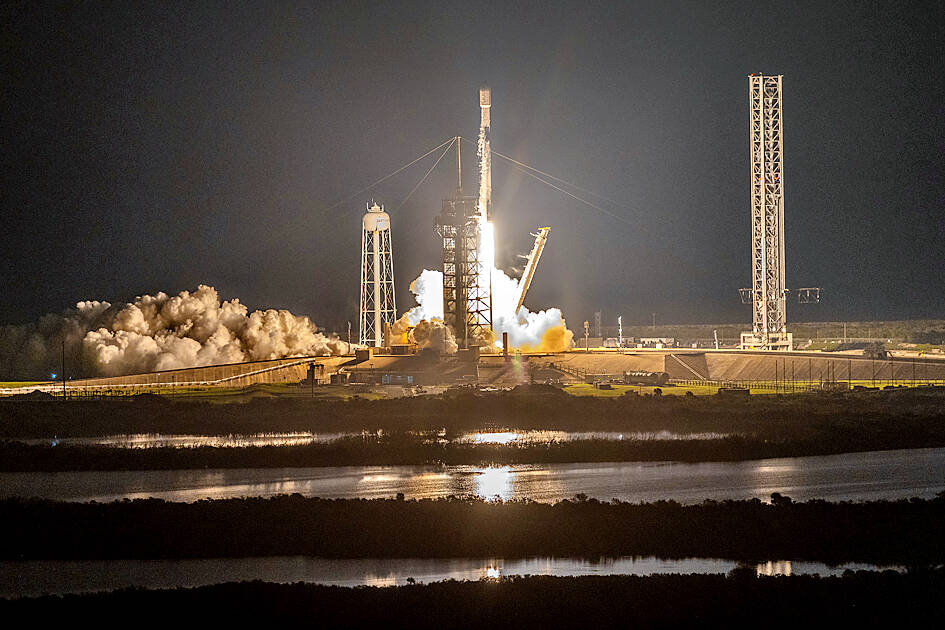A private company launched another lunar lander on Wednesday, aiming to get closer to the moon’s south pole this time with a drone that would hop into a jet-black crater that never sees the sun.
Intuitive Machines’ lander, named Athena, caught a lift with SpaceX from NASA’s Kennedy Space Center. It is taking a fast track to the moon — with a landing on Thursday next week — while hoping to avoid the fate of its predecessor, which tipped over at touchdown.
Never before have so many spacecraft angled for the moon’s surface all at once. Last month, US and Japanese companies shared a rocket and separately launched landers toward Earth’s sidekick.

Photo: EPA-EFE
Texas-based Firefly Aerospace should get there first this weekend after a big head start.
The two US landers are carrying tens of millions of dollars of experiments for NASA as it prepares to return astronauts to the moon.
“It’s an amazing time. There’s so much energy,” NASA’s science mission chief Nicky Fox said a few hours ahead of the launch.
This is not Intuitive Machines’ first lunar rodeo. Last year, the Texas company made the first US touchdown on the moon in more than 50 years, but an instrument that gauges distance did not work and the lander came down too hard and broke a leg, tipping onto its side.
Intuitive Machines said it has fixed the issue and dozens of others. A sideways landing like last time would prevent the drone and a pair of rovers from moving out. NASA’s drill also needs an upright landing to pierce beneath the lunar surface to gather soil samples for analysis.
“Certainly, we will be better this time than we were last time, but you never know what could happen,” senior vice president of space systems Trent Martin said.
It is an extraordinarily elite club. Only five countries have pulled off a lunar landing over the decades: Russia, the US, China, India and Japan. The moon is littered with wreckage from many past failures.
The 4.7m Athena would target a landing 160km from the lunar south pole. Just 400m away is a permanently shadowed crater — the ultimate destination for the drone named Grace.
Named after the late computer programming pioneer Grace Hopper, the 1m drone would make three increasingly higher and longer test hops across the lunar surface using hydrazine fueled-thrusters for flight, and cameras and lasers for navigation.
If those excursions go well, it would hop into the nearby pitch-black crater, an estimated 20m deep.
Science instruments from Hungary and Germany would take measurements at the bottom while hunting for frozen water.
It would be the first up-close peek inside one of the many shadowed craters dotting both the north and south poles. Scientists suspect these craters are packed with ice. If so, this ice could be transformed by future explorers into water to drink, air to breathe and even rocket fuel.
NASA is paying US$62 million to Intuitive Machines to get its drill and other experiments to the moon. The company, in turn, sold space on the lander to others. It also opened up the Falcon rocket to ride-sharing.
They included NASA’s Lunar Trailblazer satellite, which would fly separately to the moon over the next several months before entering lunar orbit to map the distribution of water below.

DOUBLE-MURDER CASE: The officer told the dispatcher he would check the locations of the callers, but instead headed to a pizzeria, remaining there for about an hour A New Jersey officer has been charged with misconduct after prosecutors said he did not quickly respond to and properly investigate reports of a shooting that turned out to be a double murder, instead allegedly stopping at an ATM and pizzeria. Franklin Township Police Sergeant Kevin Bollaro was the on-duty officer on the evening of Aug. 1, when police received 911 calls reporting gunshots and screaming in Pittstown, about 96km from Manhattan in central New Jersey, Hunterdon County Prosecutor Renee Robeson’s office said. However, rather than responding immediately, prosecutors said GPS data and surveillance video showed Bollaro drove about 3km

Tens of thousands of people on Saturday took to the streets of Spain’s eastern city of Valencia to mark the first anniversary of floods that killed 229 people and to denounce the handling of the disaster. Demonstrators, many carrying photos of the victims, called on regional government head Carlos Mazon to resign over what they said was the slow response to one of Europe’s deadliest natural disasters in decades. “People are still really angry,” said Rosa Cerros, a 42-year-old government worker who took part with her husband and two young daughters. “Why weren’t people evacuated? Its incomprehensible,” she said. Mazon’s

‘MOTHER’ OF THAILAND: In her glamorous heyday in the 1960s, former Thai queen Sirikit mingled with US presidents and superstars such as Elvis Presley The year-long funeral ceremony of former Thai queen Sirikit started yesterday, with grieving royalists set to salute the procession bringing her body to lie in state at Bangkok’s Grand Palace. Members of the royal family are venerated in Thailand, treated by many as semi-divine figures, and lavished with glowing media coverage and gold-adorned portraits hanging in public spaces and private homes nationwide. Sirikit, the mother of Thai King Vajiralongkorn and widow of the nation’s longest-reigning monarch, died late on Friday at the age of 93. Black-and-white tributes to the royal matriarch are being beamed onto towering digital advertizing billboards, on

POWER ABUSE WORRY: Some people warned that the broad language of the treaty could lead to overreach by authorities and enable the repression of government critics Countries signed their first UN treaty targeting cybercrime in Hanoi yesterday, despite opposition from an unlikely band of tech companies and rights groups warning of expanded state surveillance. The new global legal framework aims to bolster international cooperation to fight digital crimes, from child pornography to transnational cyberscams and money laundering. More than 60 countries signed the declaration, which means it would go into force once ratified by those states. UN Secretary-General Antonio Guterres described the signing as an “important milestone,” and that it was “only the beginning.” “Every day, sophisticated scams destroy families, steal migrants and drain billions of dollars from our economy...